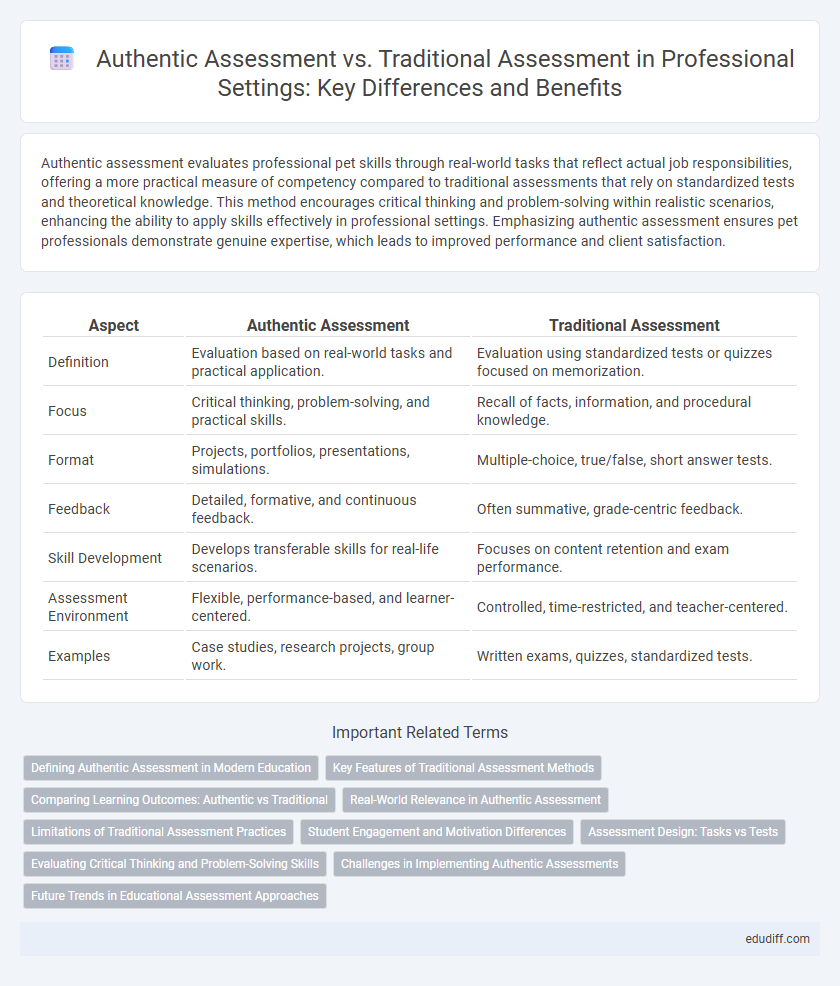Authentic assessment evaluates professional pet skills through real-world tasks that reflect actual job responsibilities, offering a more practical measure of competency compared to traditional assessments that rely on standardized tests and theoretical knowledge. This method encourages critical thinking and problem-solving within realistic scenarios, enhancing the ability to apply skills effectively in professional settings. Emphasizing authentic assessment ensures pet professionals demonstrate genuine expertise, which leads to improved performance and client satisfaction.
Table of Comparison
| Aspect | Authentic Assessment | Traditional Assessment |
|---|---|---|
| Definition | Evaluation based on real-world tasks and practical application. | Evaluation using standardized tests or quizzes focused on memorization. |
| Focus | Critical thinking, problem-solving, and practical skills. | Recall of facts, information, and procedural knowledge. |
| Format | Projects, portfolios, presentations, simulations. | Multiple-choice, true/false, short answer tests. |
| Feedback | Detailed, formative, and continuous feedback. | Often summative, grade-centric feedback. |
| Skill Development | Develops transferable skills for real-life scenarios. | Focuses on content retention and exam performance. |
| Assessment Environment | Flexible, performance-based, and learner-centered. | Controlled, time-restricted, and teacher-centered. |
| Examples | Case studies, research projects, group work. | Written exams, quizzes, standardized tests. |
Defining Authentic Assessment in Modern Education
Authentic assessment in modern education emphasizes evaluating students through real-world tasks that demonstrate practical application of skills and knowledge, contrasting with traditional assessments that rely heavily on memorization and standardized testing. This approach cultivates critical thinking, problem-solving, and collaborative abilities by engaging learners in meaningful, context-based activities. Emphasizing authentic assessment aligns educational outcomes with workforce demands and 21st-century competencies, fostering deeper understanding and retention.
Key Features of Traditional Assessment Methods
Traditional assessment methods primarily involve standardized tests, multiple-choice questions, and timed exams designed to evaluate knowledge retention and recall. These assessments emphasize uniformity, objective grading, and ease of administration, often focusing on discrete skills rather than comprehensive understanding. Despite their efficiency, traditional methods may not fully capture critical thinking, problem-solving abilities, or real-world application of knowledge.
Comparing Learning Outcomes: Authentic vs Traditional
Authentic assessment emphasizes real-world application and critical thinking, resulting in deeper understanding and transferable skills compared to traditional assessment's focus on memorization and standardized testing. Research shows that authentic assessments better measure students' ability to apply knowledge in practical contexts, enhancing problem-solving and creativity. Traditional assessments often provide quick, quantifiable data but may overlook complex cognitive processes essential for long-term learning outcomes.
Real-World Relevance in Authentic Assessment
Authentic assessment emphasizes real-world relevance by evaluating students through tasks that mirror actual professional and everyday challenges, fostering deeper understanding and practical skills. Unlike traditional assessments that rely on rote memorization and standardized tests, authentic assessment prioritizes critical thinking, problem-solving, and application of knowledge in contexts aligned with industry standards. This approach enhances student engagement and better prepares learners for workforce demands and lifelong learning.
Limitations of Traditional Assessment Practices
Traditional assessment practices often emphasize rote memorization and standardized testing, which limits their ability to measure higher-order thinking skills and real-world problem-solving abilities. Such methods frequently fail to capture student creativity, collaboration, and practical application of knowledge, resulting in an incomplete evaluation of learner competence. This narrow focus can hinder accurate assessment of individualized learning progress and critical soft skills essential for professional development.
Student Engagement and Motivation Differences
Authentic assessment enhances student engagement and motivation by involving real-world tasks that require critical thinking, problem-solving, and collaboration, making learning relevant and meaningful. Traditional assessment often relies on rote memorization and standardized testing, which can diminish intrinsic motivation and limit student connection to the material. Research indicates that students perform better and show higher motivation levels when assessments reflect practical applications rather than abstract or theoretical tasks.
Assessment Design: Tasks vs Tests
Authentic assessment prioritizes real-world tasks that reflect practical application and critical thinking, whereas traditional assessment relies on standardized tests emphasizing memorization and recall. Task-based evaluations promote deeper understanding by encouraging problem-solving and analysis within relevant contexts. This shift in assessment design fosters meaningful learning experiences aligned with professional competencies and industry standards.
Evaluating Critical Thinking and Problem-Solving Skills
Authentic assessment evaluates critical thinking and problem-solving skills by engaging learners in real-world tasks that require analysis, synthesis, and application of knowledge. Traditional assessment often relies on multiple-choice or rote memorization, which may not accurately measure a student's ability to navigate complex problems or think critically. By prioritizing scenario-based evaluations and reflective tasks, authentic assessments provide a more comprehensive measure of cognitive skills essential for professional success.
Challenges in Implementing Authentic Assessments
Implementing authentic assessments faces challenges such as the increased demand on educators' time for designing complex, real-world tasks that accurately measure student performance. Limited resources and inconsistent criteria for evaluation hinder the reliable and fair assessment of diverse skill sets. Furthermore, scalability issues arise when authentic assessments require personalized feedback and hands-on activities, complicating their integration into standardized curricula.
Future Trends in Educational Assessment Approaches
Authentic assessment emphasizes real-world tasks and critical thinking skills, aligning with the growing demand for competency-based education and personalized learning. Traditional assessment, often reliant on standardized testing, faces challenges in measuring deeper understanding and practical application of knowledge. Future trends indicate a shift toward integrating technology-driven, formative, and performance-based assessments that provide timely feedback and foster lifelong learning skills.
Authentic Assessment vs Traditional Assessment Infographic

 edudiff.com
edudiff.com